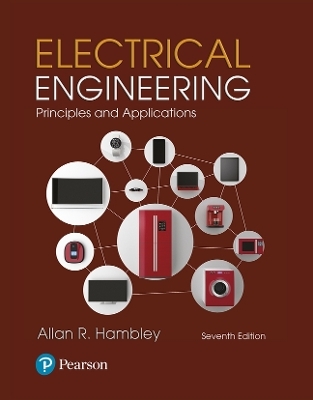
Electrical Engineering
Pearson Education (US) (Hersteller)
978-0-13-448697-0 (ISBN)
NOTE: Make sure to use the dashes shown on the Access Card Code when entering the code.
Student can use the URL and phone number below to help answer their questions:
http://247pearsoned.custhelp.com/app/home
800-677-6337
0134712870 / 9780134712871 Electrical Engineering: Principles & Applications Plus MasteringEngineering with Pearson eText -- Access Card Package, 7/e
Package consists of:
0134484142 / 9780134484143 Electrical Engineering: Principles & Applications, 7/e
0134486978 / 9780134486970 MasteringEngineering with Pearson eText -- Standalone Access Card -- for Electrical Engineering: Principles & Applications, 7/e
Allan R. Hambley received his B.S. degree from Michigan Technological University, his M.S. degree from Illinois Institute of Technology, and his Ph.D. from Worcester Polytechnic Institute. He has worked in industry for Hazeltine Research Inc., Warwick Electronics, and Harris Government Systems. He is currently Professor of Electrical Engineering at Michigan Tech. The Michigan Tech chapter of Eta Kappa Nu named him the Outstanding Electrical Engineering Teacher of the Year in 1995. He has won the National Technological University Outstanding Instructor Award six times for his courses in communication systems. The American Society for Engineering Education presented him with the 1998 Meriam Wiley Distinguished Author Award for the first edition of his book, Electronics. His hobbies include fishing, boating in remote areas of Lake Superior, and gardening.
1 Introduction
1.1 Overview of Electrical Engineering
1.2 Circuits, Currents, and Voltages
1.3 Power and Energy
1.4 Kirchhoff’s Current Law
1.5 Kirchhoff’s Voltage Law
1.6 Introduction to Circuit Elements
1.7 Introduction to Circuits
2 Resistive Circuits
2.1 Resistances in Series and Parallel
2.2 Network Analysis by Using Series and Parallel Equivalents
2.3 Voltage-Divider and Current-Divider Circuits
2.4 Node-Voltage Analysis
2.5 Mesh-Current Analysis
2.6 Thévenin and Norton Equivalent Circuits
2.7 Superposition Principle
2.8 Wheatstone Bridge
3 Inductance and Capacitance
3.1 Capacitance
3.2 Capacitances in Series and Parallel
3.3 Physical Characteristics of Capacitors
3.4 Inductance
3.5 Inductances in Series and Parallel
3.6 Practical Inductors
3.7 Mutual Inductance
3.8 Symbolic Integration and Differentiation Using MATLAB
4 Transients
4.1 First-Order RC Circuits
4.2 DC Steady State
4.3 RL Circuits
4.4 RC and RL Circuits with General Sources
4.5 Second-Order Circuits
4.6 Transient Analysis Using the MATLAB Symbolic Toolbox
5 Steady-State Sinusoidal Analysis
5.1 Sinusoidal Currents and Voltages
5.2 Phasors
5.3 Complex Impedances
5.4 Circuit Analysis with Phasors and Complex Impedances
5.5 Power in AC Circuits
5.6 Thévenin and Norton Equivalent Circuits
5.7 Balanced Three-Phase Circuits
5.8 AC Analysis Using MATLAB
6 Frequency Response, Bode Plots, and Resonance
6.1 Fourier Analysis, Filters, and Transfer Functions
6.2 First-Order Lowpass Filters
6.3 Decibels, the Cascade Connection, and Logarithmic Frequency Scales /
6.4 Bode Plots
6.5 First-Order Highpass Filters
6.6 Series Resonance
6.7 Parallel Resonance
6.8 Ideal and Second-Order Filters
6.9 Transfer Functions and Bode Plots with MATLAB
6.10 Digital Signal Processing
7 Logic Circuits
7.1 Basic Logic Circuit Concepts
7.2 Representation of Numerical Data in Binary Form
7.3 Combinatorial Logic Circuits
7.4 Synthesis of Logic Circuits
7.5 Minimization of Logic Circuits
7.6 Sequential Logic Circuits
8 Computers, Microcontrollers, and Computer-Based Instrumentation Systems
8.1 Computer Organization
8.2 Memory Types
8.3 Digital Process Control
8.4 Programming Model for the HCS12/9S12 Family
8.5 The Instruction Set and Addressing Modes for the CPU12
8.6 Assembly-Language Programming
8.7 Measurement Concepts and Sensors
8.8 Signal Conditioning
8.9 Analog-to-Digital Conversion
9 Diodes
9.1 Basic Diode Concepts
9.2 Load-Line Analysis of Diode Circuits
9.3 Zener-Diode Voltage-Regulator Circuits
9.4 Ideal-Diode Model
9.5 Piecewise-Linear Diode Models
9.6 Rectifier Circuits
9.7 Wave-Shaping Circuits
9.8 Linear Small-Signal Equivalent Circuits
10 Amplifiers: Specifications and External Characteristics
10.1 Basic Amplifier Concepts
10.2 Cascaded Amplifiers
10.3 Power Supplies and Efficiency
10.4 Additional Amplifier Models
10.5 Importance of Amplifier Impedances in Various Applications
10.6 Ideal Amplifiers
10.7 Frequency Response
10.8 Linear Waveform Distortion
10.9 Pulse Response
10.10 Transfer Characteristic and Nonlinear Distortion
10.11 Differential Amplifiers
10.12 Offset Voltage, Bias Current, and Offset Current
11 Field-Effect Transistors
11.1 NMOS and PMOS Transistors
11.2 Load-Line Analysis of a Simple NMOS Amplifier
11.3 Bias Circuits
11.4 Small-Signal Equivalent Circuits
11.5 Common-Source Amplifiers
11.6 Source Followers
11.7 CMOS Logic Gates
12 Bipolar Junction Transistors
12.1 Current and Voltage Relationships
12.2 Common-Emitter Characteristics
12.3 Load-Line Analysis of a Common-Emitter Amplifier
12.4 pnp Bipolar Junction Transistors
12.5 Large-Signal DC Circuit Models
12.6 Large-Signal DC Analysis of BJT Circuits
12.7 Small-Signal Equivalent Circuits
12.8 Common-Emitter Amplifiers
12.9 Emitter Followers
13 Operational Amplifiers
13.1 Ideal Operational Amplifiers
13.2 Inverting Amplifiers
13.3 Noninverting Amplifiers
13.4 Design of Simple Amplifiers
13.5 Op-Amp Imperfections in the Linear Range of Operation
13.6 Nonlinear Limitations
13.7 DC Imperfections
13.8 Differential and Instrumentation Amplifiers
13.9 Integrators and Differentiators
13.10 Active Filters
14 Magnetic Circuits and Transformers
14.1 Magnetic Fields
14.2 Magnetic Circuits
14.3 Inductance and Mutual Inductance
14.4 Magnetic Materials
14.5 Ideal Transformers
14.6 Real Transformers
15 DC Machines
15.1 Overview of Motors
15.2 Principles of DC Machines
15.3 Rotating DC Machines
15.4 Shunt-Connected and Separately Excited DC Motors
15.5 Series-Connected DC Motors
15.6 Speed Control of DC Motors
15.7 DC Generators
16 AC Machines
16.1 Three-Phase Induction Motors
16.2 Equivalent-Circuit and Performance Calculations for Induction Motors
16.3 Synchronous Machines
16.4 Single-Phase Motors
16.5 Stepper Motors and Brushless DC Motors
Appendices
A Complex Numbers
B Nominal Values and the Color Code for Resistors
C The Fundamentals of Engineering Examination
D Answers for the Practice Tests
E Online Student Resources
| Erscheint lt. Verlag | 11.1.2017 |
|---|---|
| Verlagsort | Upper Saddle River |
| Sprache | englisch |
| Themenwelt | Technik ► Elektrotechnik / Energietechnik |
| ISBN-10 | 0-13-448697-8 / 0134486978 |
| ISBN-13 | 978-0-13-448697-0 / 9780134486970 |
| Zustand | Neuware |
| Haben Sie eine Frage zum Produkt? |